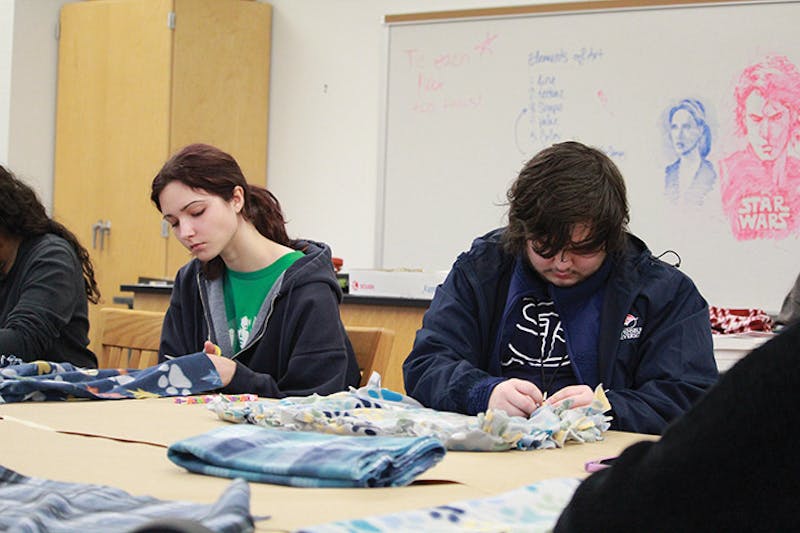Probably no one else cared about the dirty bowls that once collected on the back of a living room couch, but for two people, this was a very big deal.
What is now a bitter joke between two siblings started as an argument one year ago. SU alumni Carl Seils’ sister, Emily Kilbourne, accused him of leaving dirty bowls behind the couch, and in return he blamed her.
“She was the only one who would eat in the living room and leave bowls on the back of the couch, because I’ve seen her do it countless times,” Seils said. Her side of the story, Seils admitted, is probably the exact same as his but with reversed roles.
The argument became pretty heated, Seils said, ranking it a seven out of 10. (Eventually, “the bowls” an inside joke that helped to fizzle the tension between them, even if it didn’t solve the bowl mystery.)
“The argument makes you realize a relationship or friendship is more important. It makes you realize, yeah people fight, but it’s how you overcome those fights that help strengthen those bonds with each other. Joking about it is how we overcame it,” Seils said.
Arguments are a part of life. They are everywhere and inescapable, but that’s not necessarily a bad thing, said Kara Laskowski, a human communication studies professor at Shippensburg University.
Most people view conflict negatively, but even when they try to avoid it, they say those strategies don’t work, according to Conflict Dynamics Profile, an organization that helps people to measure and improve their conflict levels.
Conflict allows for that dialogue within one another, challenges people to grow and allows people to see things from a different perspective, said Celia Cook-Huffman, a professor of peace and conflict studies in the sociology department at Juniata College.
“For all of those reasons, I would say conflict is really critical and essential for who we are as humans,” Cook-Huffman said.
Avoid vegetables, not conflict
It’s never good to avoid a conflict, Laskowski said, but people can transform the elements that created the tension in the first place to lessen the intensity of the argument.
“When we think about conflict avoidance, it’s because people are afraid of what might happen or [they] might not know what to do,” Laskowski said. As a result, they bottle up their anger, avoid the person, and pretend everything is okay.
Instead, “diffuse” the conflict.
Laskowski used an example of two friends, one of whom is always late. A solution might be to find activities that aren’t time sensitive. Don’t go to the movies together, because you’ll probably miss the previews.
“If you practice, and you’re conscious of what you’re doing, you’re able to diffuse [conflict] before it even gets started,” Laskowski said.
Stay cool, hot head
People need to create space between the argument and their emotions, Laskowski said. Owning something makes it more personal, so keep it neutral by not calling the argument your own.
“Don’t say, ‘this is my argument.’ Say, ‘This is the argument I’m making.’ Just creating that verbal distinction provides for emotional space,” Laskowski said.
Another way to create distance between the arguments and the emotions is to take a break and come back to the discussion.
This allows for those boiling emotions to de-escalate, help people to shift their focus and maybe even realize that they actually agree on a point within the argument.
Cook-Huffman agreed that taking a break is effective but only for the right people and in the right situations.
For her personally, walking away and coming back will just lead to more anger.
“If you ask me to wait I’m just going to come up with more reasons why I’m right and your wrong,” Cook-Huffman says.
Some people are more deliberate processors and need more time to think. Others are internal processors and some like to think out loud.
On that same note, if a decision is timely within a conflict, then that should be taken care of right away.
It’s not what, but how
Cook-Huffman emphasizes a “commitment to process” in an argument. People need to decide how they’re going to have a conflict and stick to that process.
Flipping a coin would be one way to solve a conflict if both parties agree that that is the fairest way to find a solution.
“If people don’t think that the process is fair or legitimate, they’ll protest it anyway. So winning or losing is really contextual and depends on the issue and the process and what the people’s needs are,” Cook-Huffman said.
Oftentimes, what people want in a conflict is for their voice to be heard, which makes the outcome not as important.
“People can get nothing that they really want, and if they feel that the process was fair then that’s an OK outcome. People can get everything that they want and if they feel the process was unfair they might be super unhappy,” Cook-Huffman said.
Tri-colored arguments
In the middle of a courtyard, there is a rocket ship, and on one side it is red, on another it is yellow and from above the tip is blue.
There are three people, each viewing the rocket ship from a different angle. Andy Carey, counseling professor at SU, set up a scenario he uses to teach his students how conflict needs to be viewed from a frame of reference.
“Each person could say it’s yellow, it’s red, it’s blue and everybody thinks they’re right because they’re only seeing their piece. And they could get into a huge argument when everybody’s right from the point that they’re viewing it,” Carey said.
For people to better understand someone else’s point of view, Carey suggested that each person repeat what the other person is saying in his or her own words. Oftentimes, when people start to share their side of the argument, the other party immediately forms a response. Instead, people should listen first.
Dig into the heart of the matter
Ditch the labels and argue about the underlying issues, Laskowski said.
Both parties might find a commonality that is driving the issues if they are able to focus on the real meaning underneath their platforms.
“When people stop giving their position and start talking about their concerns and underlying problems, that’s when people can start to find some agreement…we try to teach student collaboration skills, which really starts with that conversation about why is it, not what is it, but why is it I have this position,” Laskowski said.
Laskowski called this “stepping in” to the argument to really understand
“It takes a bit of courage to identify and share with someone this is why I feel this way….Also stepping in and getting closer to that other person and really seeing what it is that they’re saying and where they’re coming from,” Laskowski said.
Fifty percent happy
“One of the things we frequently hear is that we all need to compromise. …compromise is not where we want to go. Compromise is 50/50. So if you get 50 percent of what you want, you’re only going to be 50 percent satisfied with that outcome,” Laskowski said.
There are more creative solutions to a conflict that can give both people what they want. If two friends want to go out to eat but they can’t agree on pizza or Chinese, then get both. It’s takeout, so order for pick up and eat it at a different location. Even if they were to get pizza this time and Chinese next time, one person would not get what he or she wants and will be unhappy. So get both.
It’s OK to disagree
When people want a certain outcome, they’re willing to disregard the person in their way to make it happen, Carey said. “Things go out the window when agendas become more important.”
People need to know that you care about them even if there is a disagreement, Carey said. Sometimes people feel personally rejected when someone discards an idea that they’re passionate about.
People think that conflicts shouldn’t happen, and the only reason they do is because someone did something wrong, Carey said.
“When you care about things in life, it’s easy for conflicts to exist. It’s normal for them to exist. I think that’s part of it. I think there are actually bigger things to learn through the conflict rather than avoiding it,” Carey said.
Back to the bowls
Some arguments are just too good to let go.
Seils bounced back and forth from joking about the argument to holding onto the grudge with a white-knuckle grip as he threatened to scatter bowls all around the house next time he saw his sister.
“It’s all in good fun. I have no hard feelings toward my sister about the bowls she accused me of leaving on the back of the couch,” Seils said, the bitterness creeping into his voice with every single word.




The Slate welcomes thoughtful discussion on all of our stories, but please keep comments civil and on-topic. Read our full guidelines here.